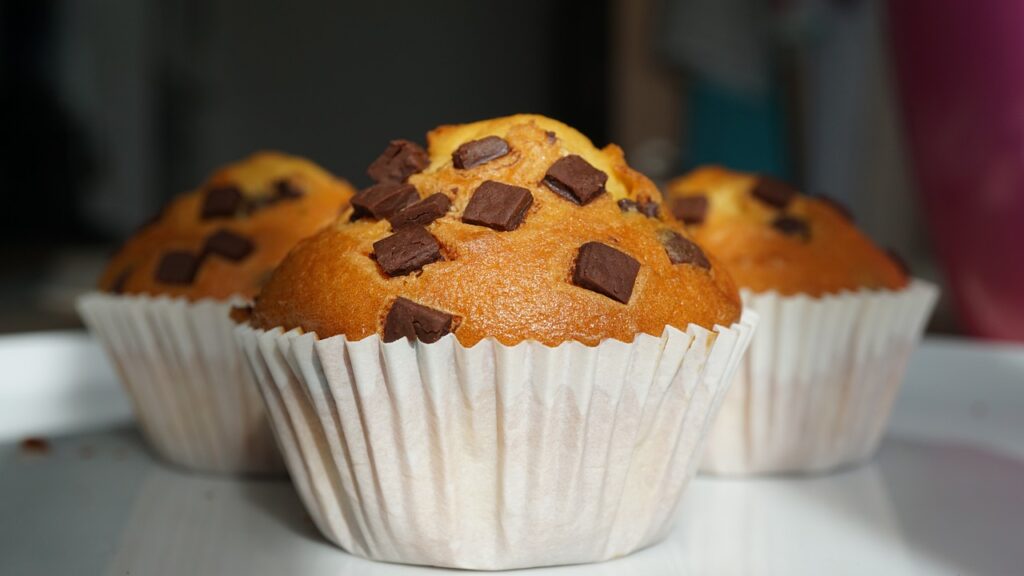Muffins have long been a favorite treat, often found in the breakfast aisle of grocery stores or as a quick snack at coffee shops. Whether they’re packed with fruit, chocolate, or nuts, muffins offer convenience, portability, and indulgence all in one. With all the different types and flavors of muffins out there, it can be difficult to determine whether they contribute to a nutritious diet or whether they’re just an empty-calorie indulgence. In this post, we’ll explore the health benefits of muffins, highlight various muffin types to help you make informed choices and also some of the interesting facts about muffins. Let’s dive in!
The Health Benefits of Muffins:
While muffins are often seen as a rich delight, there are ways to make them both delicious and nutritious. To understand the health benefits, it’s important to look at the ingredients that go into them and how they can contribute to your diet.
1. Whole Grains and Fiber:
Many muffin recipes use whole wheat flour or oats, both of which are high in fiber. Fiber helps prolong feelings of fullness and is vital for a healthy gut. Whole grains, unlike refined grains, retain the bran and germ, which contain important nutrients like B vitamins, iron, and magnesium. Fiber-rich muffins can be a great way to start your day with a satisfying breakfast that helps regulate your digestion.
2. Healthy Fats (in Moderation):
Muffins can also be made with healthy fats, such as those from nuts, seeds, or olive oil. These fats provide essential fatty acids that support heart health, brain function, and hormone regulation. When using ingredients like almonds, walnuts, or chia seeds, muffins can offer a boost of omega-3 fatty acids, which are great for lowering inflammation in the body and supporting cardiovascular health.
3. Vitamins and Minerals from Fruit:

Many muffins contain fruits like blueberries, apples, bananas, or carrots, all of which add natural sweetness as well as vitamins and minerals. For example, blueberries are high in antioxidants, which can help protect your cells from oxidative stress. Bananas add potassium, which supports healthy blood pressure levels, and apples contribute vitamin C, which is important for immune function. Including these fruits in muffin recipes can increase the nutritional value of your snack or meal.
4. Protein and Energy:
By incorporating ingredients like eggs, Greek yogurt, or nut butters, muffins can become a source of protein, which is essential for muscle repair and growth. Protein also plays a key role in regulating blood sugar levels and maintaining energy throughout the day. By adding protein to your muffins, you can enjoy a more balanced and sustaining snack.
5. Controlled Sugar Content:
Store-bought muffins, especially those from bakeries or packaged in stores, are often loaded with sugar, which can contribute to spikes in blood sugar levels and ultimately lead to energy crashes. However, homemade muffins provide an opportunity to control the amount of sugar used. You can opt for natural sweeteners such as honey, maple syrup, or even mashed bananas, which contain vitamins and minerals that refined sugar doesn’t offer. Reducing sugar intake can improve overall health, especially if you’re trying to manage your weight or blood sugar levels.
6. Customizable to Dietary Preferences:
Muffins are incredibly versatile, and with a bit of creativity, they can be tailored to suit various dietary needs, including gluten-free, dairy-free, or vegan diets. By substituting ingredients like almond flour for wheat flour or coconut milk for dairy milk, you can make muffins suitable for almost any dietary preference or restriction. This flexibility makes muffins a great choice for those with specific nutritional goals.
Types of Muffins:
Muffins come in many forms, each with its own distinct flavor and texture. Here are some of the most common types of muffins, ranging from sweet to savory:
1. Blueberry Muffins:
Blueberry muffins are a classic breakfast choice, loved for their sweet and slightly tart flavor. They can be made with whole wheat or oat flour for added fiber, and the blueberries provide antioxidants and vitamin C. Blueberry muffins are often enjoyed fresh out of the oven but also freeze well for a quick breakfast on busy mornings.
2. Banana Muffins:
Banana muffins are another popular choice, especially when you have ripe bananas that need to be used up. These muffins are naturally sweet due to the bananas and can be made with whole wheat flour for a fiber boost. They are rich in potassium, a key nutrient for maintaining heart health. You can even add a handful of nuts or chocolate chips for extra flavor.
3. Carrot Muffins:
Carrot muffins offer a deliciously spiced treat while sneaking in some vegetables. Carrots provide vitamin A and beta-carotene, which support eye health and immune function. Carrot muffins can be made with whole wheat flour and flavored with cinnamon and ginger, making them a comforting and nutritious option.
4. Zucchini Muffins:
They are a great way to sneak more vegetables into your diet. Zucchini is low in calories and high in water content, making it an excellent ingredient for keeping muffins moist without adding extra fat. It also provides vitamins C and K, as well as fiber. You can even add a touch of lemon zest or walnuts to enhance the flavor.
5. Apple Cinnamon Muffins:
Apple cinnamon muffins combine the warm flavors of cinnamon with the sweetness of apples. Apples are a good source of fiber and vitamin C, while cinnamon has anti-inflammatory properties and may help regulate blood sugar levels. These muffins are often made with whole wheat flour for a heart-healthy option.
6. Savory Muffins:
Not all muffins need to be sweet! Savory muffins are an excellent choice for those who prefer a more filling, non-sugary snack. Ingredients like cheese, herbs, spinach, and even bacon can be added to savory muffins. These muffins can be enjoyed as part of a meal, and they provide protein, fiber, and healthy fats.
7. Gluten-Free Muffins:
For those who are sensitive to gluten or have celiac disease, gluten-free muffins offer a tasty alternative. These muffins can be made using almond flour, coconut flour, and rice flour. They are just as delicious as traditional muffins, and you can still add nutritious ingredients like fruit, nuts, or seeds.
8. Vegan Muffins:
Vegan muffins are made without animal products, so they don’t contain dairy or eggs. Instead of eggs, ingredients like flaxseed meal or chia seeds are used to help bind the mixture. Almond milk or coconut milk often replaces regular milk, making these muffins perfect for plant-based diets. Vegan muffins can be just as delicious and satisfying as their non-vegan counterparts, and they can be made with wholesome ingredients like oats, bananas, or nut butters.
Interesting facts about muffins:
1. Muffins Were Originally British.
The muffin we know today is an American creation, but the term “muffin” originated in Britain. British muffins were originally flat, round, and cooked on a griddle, resembling what Americans call English muffins. The American-style muffin, a sweet, cake-like pastry, emerged later, during the 18th and 19th centuries.
2. Muffins Are Different from Cupcakes.
Though muffins and cupcakes may look similar, they’re not the same. The primary difference is the sweetness level and texture. Muffins are generally less sweet and denser, often made with healthier ingredients like whole grains or fruits. Cupcakes, on the other hand, are typically sweeter and lighter, made with more sugar and butter, and often topped with frosting.
3. Muffins Can Be Made with Many Flours.
While the classic muffin is made with all-purpose flour, you can make muffins with a variety of flours to suit dietary preferences. For example, almond flour, oat flour, and coconut flour are popular gluten-free alternatives, offering different textures and flavors while catering to those with gluten sensitivities.
4. The First Muffin Mix Was Created in the 1930s.
The convenience of boxed muffin mixes became popular in the 1930s. General Mills introduced the first-ever muffin mix called “Betty Crocker Muffin Mix,” making it easy for people to bake muffins at home without starting from scratch. This product helped popularize the idea of homemade muffins in households across America.
5. Muffins Are Often Healthier Than Store-Bought Snacks.
Homemade muffins can be a healthier option than many store-bought snacks, especially if made with whole grains, fruits, and nuts. While store-bought muffins can be loaded with sugar and preservatives, homemade muffins allow you to control the ingredients and make them more nutritious.
6. Muffins Were Originally a Breakfast Food.
In the past, muffins were traditionally a breakfast item. Their portability and ability to be easily paired with a cup of coffee or tea made them a popular choice in the morning. Over time, muffins have become a versatile snack enjoyed at any time of day, not just at breakfast.
7. Muffin Tops Are a Popular Phenomenon.

Many people love the top part of a muffin more than the rest. The muffin top is the rounded, crisp, and slightly caramelized part of the muffin that typically rises above the tin during baking. Due to this popularity, “muffin top” is also used to describe the extra weight that can accumulate around the waist, but in baking, it’s considered a delightful treat!
8. Muffins Can Be Savory Too.
While most people associate muffins with sweet flavors, savory muffins are just as popular. Ingredients like cheese, bacon, spinach, and herbs can be incorporated into savory muffin recipes, offering a flavorful option for lunch or dinner. These can be enjoyed on their own or as a side dish to soups and salads.
9. Muffins Can Be Freezable.
Muffins are one of the easiest baked goods to freeze. If you make a large batch, you can store individual muffins in the freezer for later use. Simply place them in an airtight container or freezer bag, and they can be thawed out or reheated whenever you’re in the mood for a quick snack or breakfast.
10. There’s a National Muffin Day.
Did you know that there is a holiday dedicated to muffins? National Muffin Day is celebrated on March 11th every year. It’s a day for muffin lovers to enjoy their favorite muffin varieties, whether they’re homemade, from a bakery, or store-bought. It’s the perfect excuse to treat yourself to a muffin (or two)!
These fun and surprising muffin facts add a bit of history, trivia, and creativity to your understanding of this beloved pastry!
Are muffins different from cupcakes?
Yes, muffins and cupcakes are different in several key ways, although they may look similar at first glance. Here’s a breakdown of the key differences:
| Feature | Muffins | Cupcakes |
|---|---|---|
| Sweetness | Less sweet | Very sweet |
| Texture | Denser, coarser | Lighter, fluffier, cake-like |
| Main Purpose | Breakfast or snack | Dessert or celebration treat |
| Toppings | Often plain or lightly topped | Frosted with decorative toppings |
| Ingredients | Simpler, often healthier ingredients | Richer, sweeter, often with buttercream |
| Mixing Method | Muffin method (minimal mixing) | Creaming method (beating butter & sugar) |
In conclusion, muffins and cupcakes are both delicious baked goods, but they differ in terms of sweetness, texture, and purpose. Muffins are generally a more wholesome option, while cupcakes are indulgent and often served as a treat for special occasions.
Conclusion:
Muffins don’t have to be a guilty pleasure. By choosing the right ingredients and making them at home, you can turn muffins into a healthy, nutritious snack or breakfast option. Whether you opt for a fiber-packed whole grain muffin, a protein-rich option with nuts, or a fruit-filled treat loaded with vitamins, muffins can be a great addition to your diet.
The key is to focus on wholesome, natural ingredients and avoid excess sugar, refined flour, and unhealthy fats. With a bit of creativity and a few simple swaps, you can enjoy a delicious muffin that’s both healthy and satisfying. So next time you reach for a muffin, you’ll know exactly how to make it a nutritious choice!

